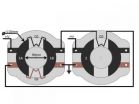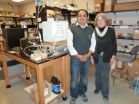(Press-News.org) Battery technology hasn't kept pace with advancements in portable electronics, but the race is on to fix this. One revolutionary concept being pursued by a team of researchers in New Zealand involves creating "wearable energy harvesters" capable of converting movement from humans or found in nature into battery power.
A class of variable capacitor generators known as "dielectric elastomer generators" (DEGs) shows great potential for wearable energy harvesting. In fact, researchers at the Auckland Bioengineering Institute's Biomimetics Lab believe DEGs may enable light, soft, form-fitting, silent energy harvesters with excellent mechanical properties that match human muscle. They describe their findings in the American Institute of Physics' journal Applied Physics Letters.
"Imagine soft generators that produce energy by flexing and stretching as they ride ocean waves or sway in the breeze like a tree," says Thomas McKay, a Ph.D. candidate working on soft generator research at the Biomimetics Lab. "We've developed a low-cost power generator with an unprecedented combination of softness, flexibility, and low mass. These characteristics provide an opportunity to harvest energy from environmental sources with much greater simplicity than previously possible."
Dielectric elastomers, often referred to as artificial muscles, are stretchy materials that are capable of producing energy when deformed. In the past, artificial muscle generators required bulky, rigid, and expensive external electronics.
"Our team eliminated the need for this external circuitry by integrating flexible electronics—dielectric elastomer switches—directly onto the artificial muscles themselves. One of the most exciting features of the generator is that it's so simple; it simply consists of rubber membranes and carbon grease mounted in a frame," McKay explains.
McKay and his colleagues at the Biomimetics Lab are working to create soft dexterous machines that comfortably interface with living creatures and nature in general. The soft generator is another step toward fully soft devices; it could potentially be unnoticeably incorporated into clothing and harvest electricity from human movement. When this happens, worrying about the battery powering your cell phone or other portable electronics dying on you will become a thing of the past. And as an added bonus, this should help keep batteries out of landfills.
INFORMATION:
Replacing batteries may become a thing of the past, thanks to 'soft generators'
2011-04-07
ELSE PRESS RELEASES FROM THIS DATE:
Common nanoparticles found to be highly toxic to Arctic ecosystem
2011-04-07
Queen's researchers have discovered that nanoparticles, which are now present in everything from socks to salad dressing and suntan lotion, may have irreparably damaging effects on soil systems and the environment.
"Millions of tonnes of nanoparticles are now manufactured every year, including silver nanoparticles which are popular as antibacterial agents," says Virginia Walker, a professor in the Department of Biology. "We started to wonder what the impact of all these nanoparticles might be on the environment, particularly on soil."
The team acquired a sample of soil ...
Common Safety Myths Can Cause More Harm than Good to Motorcyclists
2011-04-07
There are many misunderstandings circulating about the best ways for motorcycle riders to avoid being involved in accidents with other cars. In some cases, these myths about motorcycle accidents can do more harm than good -- and put motorcyclists' lives at risk.
Motorcycle riders are eight times more likely than those in passenger vehicles to be seriously injured in an accident and 35 times more likely to die in an accident. With these statistics in mind, it is important for motorcyclists to know the best ways to protect their safety - and what legal options they have ...
Micro aircraft IMPULLS improves avionic systems and sensors
2011-04-07
A novel test aircraft of the TU Muenchen successfully completed its maiden flight yesterday at the airfield of the MFC Red Baron near Heimstetten. The micro aircraft christened "IMPULLS" (Innovative Modular Payload UAV – TUM LLS) will facilitate testing aviation sensors and systems. It was jointly developed by postgraduate students at the Institute of Aircraft Design and the Institute of Flight System Dynamics in Garching. Propelled by a compact electric motor, the aircraft flies quietly and free of emissions.
A particularly important feature of the novel design is its ...
Bronx Bus Accident Claims 15 NYC Lives, Negligent Hiring Suspected
2011-04-07
Witnesses to a recent fatal bus crash in the Bronx told law enforcement that the bus was veering erratically before flipping onto one side and striking a sign post. The post sliced through the passenger compartment almost to the rear of the vehicle, creating horrific carnage in the passenger area and nearly removing the roof. The bus was returning from a Connecticut casino to Chinatown in Manhattan when the accident occurred early on a Saturday morning, just after the bus entered the Bronx from Westchester County.
A host of reports soon after indicated that the driver, ...
Seeing rice with X-rays may improve crop yields
2011-04-07
College Park, Md. (April 6, 2011) -- Most people experience X-ray computed tomography (CT) scanners when they are evaluated for a suspected tumor or blood clot. But in the lab of Dr. Quin Liu, PhD., in Wuhan China, rice plants were the patients in a novel use of CT scanners as part of an agriculture study to increase rice yield.
Into the CT scanner on a conveyor belt went little potted rice plants in an automated facility that could process 4,320 rice plants a day. The non-invasive CT energy analyzed tissues and matched their traits against a computer program to aid ...
Malpractice Case Highlights Expert Testimony Disclosure in Connecticut
2011-04-07
When it comes to arguing and proving medical malpractice claims at trial, providing strong expert testimony to support these cases is crucial. The Supreme Court of Connecticut recently decided a case, Klein v. Norwalk, which highlights this important tactic, as well as the standard for disclosing what points an expert will make during testimony. Although this case had a long and difficult journey through multiple Connecticut courts, and continues to make waves, the Connecticut Supreme Court made Klein v. Norwalk a noteworthy opinion.
Klein's Claim
According to the ...
Here's looking at you!
2011-04-07
CORAL GABLES, FL (April 6, 2011)—Learning how babies communicate can teach us a lot about the development of human social interactions. Psychologist Daniel Messinger, from the University of Miami (UM), studies infants' interactions and has found that babies are not simply living in the moment. Instead, infants seem to have particular interests that create historical footprints reflected in the infants' visual engagement over time. The findings were published today, in a study titled, 'Are You Interested, Baby?' Young Infants Exhibit Stable Patterns of Attention during Interaction." ...
New device promises safer way to deliver powerful drugs
2011-04-07
College Park, Md. (April 6, 2011) -- A new drug delivery device designed and constructed by Jie Chen, Thomas Cesario and Peter Rentzepis promises to unlock the potential of photosensitive chemicals to kill drug-resistant infections and perhaps cancer tumors as well.
Photosensitive chemicals are molecules that release single oxygen atoms and chemical radicals when illuminated. These radicals are very active chemically, and can rip apart and destroy bacteria, said Peter Rentzepis, a professor of chemistry at University of California, Irvine.
Yet photosensitive chemicals ...
Planning Issues for Elderly Parents
2011-04-07
Watching your parents age is an emotional and often challenging experience. For members of the "sandwich" generation, the need to consider care for aging parents comes while parenting duties for their own children continue. The double-duty can be difficult, especially serious health and financial issues are involved.
The Child Becomes the Caregiver
For example, many adult children must make sudden decisions when mom or dad falls and breaks a hip or is diagnosed with the first signs of Alzheimer's disease.
Once this happens, the tables have turned, and the child ...
Adolescent body mass index can predict young adulthood diabetes and heart disease
2011-04-07
BEER-SHEVA, ISRAEL - April 7, 2011 – A large cohort study following 37,000 teenagers for 17 years found that an elevated, yet normal range Body Mass Index (BMI) constitutes a substantial risk factor for obesity-related disorders in young adults (age 30-40).
The study showed that elevated BMI in adolescence has distinctive relationships with type 2 diabetes and coronary heart disease in young adulthood.
Researchers showed that diabetes is influenced mainly by recent BMI and weight gain. However, for coronary heart disease, both elevated BMI in adolescence and recent ...


